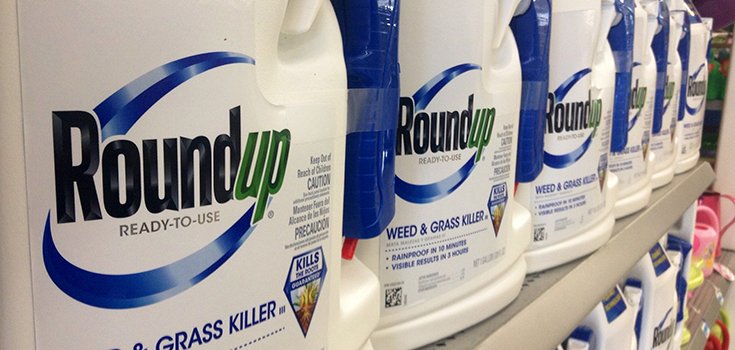Ding Ding! EU Committee Votes AGAINST Renewal of Glyphosate Herbicide

Monsanto may be in trouble in Europe. After months of controversy over disparaging studies concerning Round Up’s main ingredient, glyphosate, the Committee on Environment, Food Safety & Public Health (ENVI) has formally objected to the re-authorization by the European Commission of the herbicide.
Voting to uphold this objection were 36 members, while 6 members voted against it and 18 did not vote.
Members also called the herbicide’s re-authorization “irresponsible and unacceptable.”
MEP Anja Hazekamp criticized the European Commission for even considering giving Round Up the green light in Europe:
“With this decision, the European Commission fails to protect the health of humans, animals, and the environment. Member states and more than 1 million citizens have already expressed their concerns over the re-authorisation. We will use all possible means to prevent the European Commission from contaminating our environment for another 15 years.”
Related Read: Landmark Report: Glyphosate is Most Heavily Used Herbicide in History
Joining Hazekamp in voicing concern was German GUE/NGL MEP Stefan Eck:
“Glyphosate definitely causes major health risks to animals. According to IARC, [the World Health Organisation agency specialized in cancer which assessed all existing scientific studies on glyphosate,] there is enough scientific evidence to define this herbicide as carcinogenic in animals.
Humans are also exposed to major health risks by the widespread use of glyphosate. In this case, the precautionary principle should be fully respected!”
Letter Urges EU to STOP Re-Approval of Glyphosate Herbicide
In January, 2014, 67 Members of the European Parliament (MEPs) wrote a letter asking for the re-approval to be rejected.
The letter to Vytenis Andriukaitis focused attention on the scientific controversy between the European Food Safety Agency (EFSA) and the International Agency for Research on Cancer of the World Health Organization (IARC) with regard to the carcinogenicity of glyphosate.
The IARC called glyphosate ‘probably carcinogenic,’ while the EFSA peer review, based on the renewal assessment report by the rapporteur Member State (BfR), concluded that glyphosate is “unlikely to pose a carcinogenic hazard to humans and the evidence does not support classification with regard to its carcinogenic potential.”
The letter stated:
“With regard to the first point, EFSA stated that its “evaluation considered a large body of evidence, including a number of studies not assessed by the IARC which is one of the reasons for reaching different conclusions” (EFSA news story, 12 November 2015).
In a detailed response to an open letter sent by MEPs and MPs on 20 October 2015, EFSA gives further indications: “Based on a comprehensive genotoxicity data package on the active substance glyphosate and considering a weight of evidence approach on all available data, it is concluded that glyphosate is unlikely to be genotoxic in vivo and does not require hazard classification regarding mutagenicity according to the CLP Regulation. It is noted that unpublished studies that were the core basis of the peer review evaluation were not available to the IARC experts as reported in the IARC monograph 112 on glyphosate (IARC, 2015)[own emphasis added].
Moreover, EFSA admitted that a number of published studies performed with glyphosate-based formulations of unknown composition gave positive results when tested in vitro and in vivo. EFSA furthermore acknowledged that POE-tallowamine is one of the co-formulants that is known to be used in some glyphosate-based formulations, and that « this co-formulant has been shown to be more toxic than the active substance glyphosate on several toxicological endpoints, namely acute, short term, reproductive and developmental toxicity, further to equivocal evidence of DNA damage in vitro at high doses ». However, according to EFSA, POE-tallowamine is not present in the representative formulation.
We are very concerned that an applicant may get approval for an active substance based on one plant protection product alone, especially when many different formulations are placed on the market, most likely choosing a formulation with the least harmful co-formulants, despite the wide use of such highly problematic co-formulants such as POE-tallowamine.
EFSA concluded that the toxicity of formulations and in particular their genotoxic potential should be further considered and addressed, leaving that task to Member States. However, given the hazards shown by formulations, and in particular by POE-tallowamine, and without prejudice to our concerns with regard to the carcinogenic properties of glyphosate as found by IARC, it seems that Member States are not properly applying Article 4(3) of Regulation (EC) No 1107/2009.
We would therefore like to know whether you consider that EFSA complied with Article 4(5) and whether it assessed the most relevant plant protection product in that context, and how you want to ensure that Member States properly apply the provisions of the Regulation, and in particular its Article 4(3) with regard to the authorisation of plant protection products.
Finally, we are greatly concerned that glyphosate may be reapproved prior to the adoption of scientific criteria for the determination of endocrine disrupters. Glyphosate-based formulations have been found to be endocrine disrupters in human cell lines (see Gasnier et al., Toxicology, 21 August 2009). In the absence of proper scientific criteria, EFSA only assessed glyphosate against the interim criteria for endocrine disrupters, yet stated that an endocrine-mediated mode of action could not be ruled out in the context of possible adverse effects on reproduction.”
As you know, the Commission was obliged to present scientific criteria by 14 December 2013 but failed to do so. An analogous obligation is laid down in the Biocides Regulation EU (No) 528/2012. In this context, the General Court declared on 16 December 2015 that the Commission has breached EU law by failing to adopt delegated acts as regards the specification of the scientific criteria for the determination of the endocrine-disrupting properties.”
Now if US regulators would similarly see the light.
